What's New
Displaying results 41 - 50 of 4052
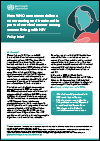
Resource | Publications,
The new and updated WHO recommendations are intended to support countries to scale up access to and uptake of cervical cancer screening and treatment with quality modern technologies and thereby improve coverage of both screening and treatment and reduce cervical cancer disease and deaths.
This policy brief highlights the key features of the new recommendations on screening and treatment for cervical pre-cancer among women living with HIV, and includes programme considerations for implementation including service delivery, service integration and addressing barriers to access.
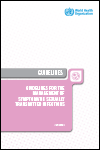
Resource | Guidelines,
The objectives of these guidelines are to provide updated, evidence-informed clinical and practical recommendations on the case management of people with symptoms of STIs; and to support countries in updating their national guidelines for the case management of people with symptoms of STIs. These guidelines include the management of symptomatic infections related to urethral discharge syndrome, including persistent urethral discharge syndrome; vaginal discharge syndrome, including persistent vaginal discharge; anorectal infection; genital ulcer disease syndrome; and lower abdominal pain syndrome. These guidelines are intended for programme managers for STI prevention and control at the national level and the health-care providers at the frontline – primary, secondary and tertiary health care.
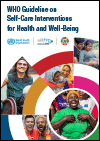
Resource | Guidelines,
The World Health Organization (WHO) uses the following working definition of self-care: Self-care is the ability of individuals, families and communities to promote health, prevent disease, maintain health, and cope with illness and disability with or without the support of a health worker. The scope of self-care as described in this definition includes health promotion; disease prevention and control; self-medication; providing care to dependent persons; seeking hospital/specialist/primary care if necessary; and rehabilitation, including palliative care. It includes a range of self-care modes and approaches. While this is a broad definition that includes many activities, it is important for health policy to recognize the importance of self-care, especially where it intersects with health systems and health professionals.
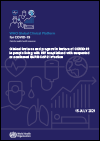
Resource | Publications,
This report describes the demographics, clinical presentation, clinical outcomes, and risk factors among people living with HIV (PLHIV) who have been hospitalized for suspected or confirmed COVID-19.
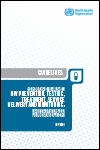
Resource | Guidelines,
These consolidated guidelines on HIV prevention, testing, treatment, service delivery and monitoring bring together existing and new clinical and programmatic recommendations across different ages, populations and settings, bringing together all relevant WHO guidance on HIV produced since 2016. It serves as an update to the previous edition of the consolidated guidelines on HIV.
These guidelines continue to be structured along the continuum of HIV care. Information on new combination prevention approaches, HIV testing, ARV regimens and treatment monitoring are included. There is a new chapter on advanced HIV disease that integrates updated guidance on the management of important HIV comorbidities, including cryptococcal disease, histoplasmosis and tuberculosis. The chapter on general HIV care, contains a new section on palliative care and pain management, and up to date information on treatment of several neglected tropical diseases, such as visceral leishmaniasis and Buruli ulcer. New recommendations for screening and treating of cervical pre-cancer lesions in women living with HIV are also addressed in this chapter.
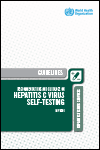
Resource | Publications,
WHO has set a global goal to eliminate HCV as a public health problem by 2030. WHO estimates that 58 million people had chronic hepatitis C virus (HCV) infection globally in 2019, and less than a quarter of them were diagnosed. New and innovative approaches are needed to accelerate progress toward the HCV elimination targets. Self-testing is one such approach.
These guidelines provide a new recommendation and guidance on HCV self-testing to complement existing HCV testing services in countries. These guidelines also highlight operational considerations to support strategic implementation and scale up of HCV self-testing.
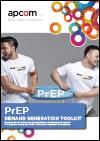
Resource | Tools,
The aim of this toolkit is to support community organizations to increase awareness of and generate demand for PrEP for HIV prevention; from design and implement sex-positive activities to promote and increase demand of PrEP at the country level, to establishing collaboration and engagements with healthcare providers, civil society organizations, private sectors and other stakeholders in developing sustainable online campaign which adequately respond to the needs of key population communities at the country level.

Resource | Publications,
In 2019, there were an estimated 1.9 million people living with HIV (PLHIV) in the Western Pacific Region. Regional HIV prevalence and annual new HIV infections have remained unchanged since 2010 at 0.1% and 100 000 new infections per year, respectively. Among PLHIV, 77% have been diagnosed and 84% of diagnosed PLHIV were receiving antiretroviral therapy (ART). Of those on ART, 94% achieved viral suppression. While countries in the Region are making progress towards elimination of HIV, there were an estimated 437 000 PLHIV still undiagnosed in 2019.

Resource | Publications,
Since the framework was launched, UNAIDS and partners have reported annually on progress towards achieving these targets. Since the deadline for achieving the targets passed in December 2020, this is the final Start Free, Stay Free, AIDS Free progress report. Although the targets were global, partners identified 23 countries for intensified focus under the framework. This report specifically highlights progress against the targets in focus countries.
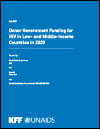
Resource | Publications,
The new report, produced as a long-standing partnership between KFF and UNAIDS for more than 15 years, provides the latest data available on donor government funding based on data provided by governments. It includes their bilateral assistance to low- and middle-income countries and contributions to the Global Fund, UNAIDS, and UNITAID. “Donor government funding” refers to disbursements, or payments, made by donors.





